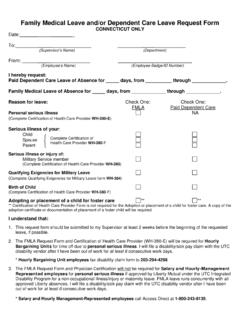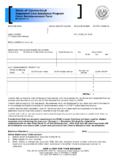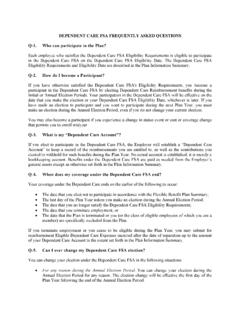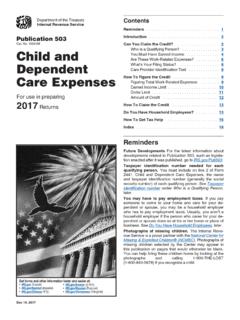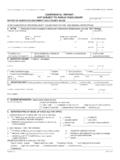Transcription of 2017 Instructions for Form 2441 - irs.gov
1 Userid: CPMS chema: instrxLeadpct: 100%Pt. size: 10 Draft Ok to PrintAH XSL/XMLF ileid: .. ions/I2441/2017/A/XML/Cycle04/source(Ini t. & Date) _____Page 1 of 6 11:09 - 19-Sep-2017 The type and rule above prints on all proofs including departmental reproduction proofs. MUST be removed before for Form 2441 Child and Dependent Care ExpensesDepartment of the TreasuryInternal Revenue ServiceFuture DevelopmentsFor the latest information about developments related to Form 2441 and its Instructions , such as legislation enacted after they were published, go to of FormIf you paid someone to care for your child or other qualifying person so you (and your spouse if filing jointly) could work or look for work in 2017, you may be able to take the credit for child and dependent care addition, if you (or your spouse if filing jointly) received any dependent care benefits for 2017, you must use Form 2441 to figure the amount, if any, of the benefits you can exclude from your income.
2 You must complete Part III of Form 2441 before you can figure the credit, if any, in Part (and your spouse if filing jointly) must have earned income to take the credit or exclude dependent care benefits from your income. But, see If You or Your Spouse Was a Student or Disabled, later if either of these circumstances information. See Pub. 503, Child and Dependent Care Expenses, for more Care BenefitsDependent care benefits include:Amounts your employer paid directly to either you or your care provider for the care of your qualifying person(s) while you worked,The fair market value of care in a daycare facility provided or sponsored by your employer, andPre-tax contributions you made under a dependent care flexible spending arrangement (FSA).Your salary may have been reduced to pay for these benefits.
3 If you received dependent care benefits as an employee, they should be shown in box 10 of your 2017 Form(s) W-2. Benefits you received as a partner should be shown in box 13 of your Schedule K-1 (Form 1065) with code Person(s)A qualifying person qualifying child under age 13 whom you can claim as a dependent. If the child turned 13 during the year, the child is a qualifying person for the part of the year he or she was under age disabled spouse who wasn't physically or mentally able to care for himself or disabled person who wasn't physically or mentally able to care for himself or herself whom you can claim as a dependent or could claim as a dependent disabled person had gross income of $4,050 or more, disabled person filed a joint return, (or your spouse if filing jointly) could be claimed as a dependent on another taxpayer's 2017 you are divorced or separated, see Special rule for children of divorced or separated parents, find out who is a qualifying child and who is a dependent, see Pub.
4 501, Exemptions, Standard Deduction, and Filing be a qualifying person, the person must have lived with you for more than half of rule for children of divorced or separated pa-rents. Even if you can't claim your child as a dependent, he or she is treated as your qualifying person if:The child was under age 13 or wasn't physically or mentally able to care for himself or herself, andYou were the child's custodial parent. The custodial parent is the parent with whom the child lived for the greater number of nights in 2017. If the child was with each parent for an equal number of nights, the custodial parent is the parent with the higher adjusted gross income. For details and an exception for a parent who works at night, see Pub. noncustodial parent can't treat the child as a qualifying person even if that parent is entitled to claim the child as a dependent under the special rules for a child of divorced or separated ExpensesThese include amounts paid for household services and care of the qualifying person while you worked or looked for work.
5 Child support payments aren't qualified expenses. Also, expenses reimbursed by a state social service agency aren't qualified expenses unless you included the reimbursement in your , if you worked or actively looked for work during only part of the period in which you incurred the expenses, you must figure your expenses for each day. However, there are special rules for temporary absences or part-time work. See Pub. 503 for more ServicesThese are services needed to care for the qualifying person as well as to run the home. They include, for example, the services of a cook, maid, babysitter, housekeeper, or cleaning person if the services were partly for the care of the qualifying person. Don't include services of a chauffeur or !Sep 19, 2017 Cat. No. 10842 KPage 2 of 6 Fileid.
6 Ions/I2441/2017/A/XML/Cycle04/source11:0 9 - 19-Sep-2017 The type and rule above prints on all proofs including departmental reproduction proofs. MUST be removed before can also include your share of the employment taxes paid on wages for qualifying child and dependent care of the Qualifying PersonCare includes the cost of services for the qualifying person's well-being and protection. It doesn't include the cost of food, lodging, education, clothing, or can include the cost of care provided outside your home for your dependent under age 13 or any other qualifying person who regularly spends at least 8 hours a day in your home. If the care was provided by a dependent care center, the center must meet all applicable state and local regulations. A dependent care center is a place that provides care for more than six persons (other than persons who live there) and receives a fee, payment, or grant for providing services for any of those persons, even if the center isn't run for can include amounts paid for items other than the care of your child (such as food and schooling) only if the items are incidental to the care of the child and can't be separated from the total cost.
7 But don't include the cost of schooling for a child in kindergarten or above. You can include the cost of a day camp, even if it specializes in a particular activity, such as computers or soccer. But don't include any expenses for sending your child to an overnight camp, summer school, or a tutoring ExpensesSome disabled spouse and dependent care expenses can qualify as medical expenses if you itemize deductions on Schedule A (Form 1040). However, you can't claim the same expense as both a dependent care expense and a medical expense. See Pub. 502, Medical and Dental Expenses, and Pub. 503 for Can Take the Credit or Exclude Dependent Care Benefits?You can take the credit or the exclusion if all five of the following filing status may be single, head of household, qualifying widow(er) with dependent child, or married filing jointly.
8 If your filing status is married filing separately, see Married Persons Filing Separately, care was provided so you (and your spouse if filing jointly) could work or look for work. However, if you didn't find a job and have no earned income for the year, you can't take the credit or the exclusion. But if you or your spouse was a full-time student or disabled, see the Instructions for lines 4 and 5, care must be for one or more qualifying person who provided the care wasn't your spouse, the parent of your qualifying child, or a person whom you can claim as a dependent. If your child provided the care, he or she must have been age 19 or older by the end of 2017, and he or she can't be your report the required information about the care provider on line 1 and, if taking the credit, the information about the qualifying person on line Persons Filing SeparatelyGenerally, married persons must file a joint return to claim the credit.
9 If your filing status is married filing separately and all of the following apply, you are considered unmarried for purposes of claiming the credit on Form lived apart from your spouse during the last 6 months of home was the qualifying person's main home for more than half of paid more than half of the cost of keeping up that home for you meet all the requirements to be treated as unmarried and meet items 2 through 5 listed earlier, you can take the credit or the exclusion. If you don't meet all the requirements to be treated as unmarried, you can't take the credit. However, you can take the exclusion if you meet items 2 through Amy separated from her spouse in March. She isn't separated under a decree of divorce or separate maintenance agreement and uses the married filing separate filing status.
10 Amy maintains a home for herself and Sam, her disabled brother. Sam is permanently and totally disabled and unable to care for Sam earns $5,600 in interest income Amy can't claim him as a dependent (his gross income is greater than the exemption amount, $4,050). And, because Amy isn't able to claim Sam as a dependent and she is still married as of the end of the year, she can't use the head of household filing status. Amy's filing status is married filing separately and Sam qualifies as a qualifying person for the child and dependent care of the following facts Amy is able to claim the credit for child and dependent care expenses even though Amy uses the married filing separate filing status:Amy didn't live with her spouse for the last six months of the has maintained a home for herself and Sam (a qualifying individual) since she separated from her spouse in maintains her own household and provides more than half of the cost of maintaining that home for herself and pays an adult daycare center to care for Sam to allow her to InstructionsLine 1 Complete columns (a) through (d) for each person or organization that provided the care.










